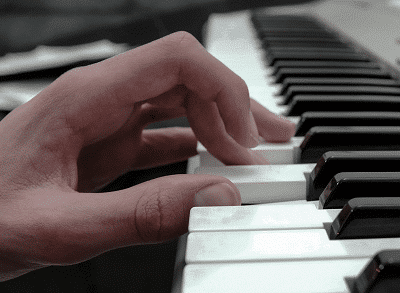I don’t know if you can play a musical instrument (I hope you can whistle at least) but I think everyone should learn a little on something other than the lips. Buy a pair of maracas, bongos, a tambourine, a set of drums, or a harmonica, a fife, a didgeridoo, a ukulele, a mandolin, a banjo, an acoustic six or electric twelve-string guitar. I left out the violin because I don’t like the bow. Mostly I recommend learning the piano. You don’t have to buy one, although I would love to have a real, live version of what’s called a harpsichord. No, all you need is a musical keyboard. In fact, even the most moderately priced keyboards can duplicate all the instruments above, and many, many more. Well perhaps not a didgeridoo, but it should.
My old keyboard stopped working way back when and I couldn’t fix it, especially after I took it apart. So now I’m using my granddaughter’s board for my grand project. I’m in the midst of transcribing 1970’s composition notebooks that are full of lyrics, with chords above the words, into actual sheet music. They’re the songs I wrote when I was young and played the guitar every day, and I’m doing the same with songs my oldest friend Stoney wrote. But to add notes to the staff of the on-screen NoteWorthy Composer program I’m using, I first have to figure out what the notes are and what key each song is in. And I have to tell you that it’s been and is still an ongoing education.
To make sure the notes match the chords I have to study the chords on the piano and I am astonished at how simple I find most of them are. Keep in mind that there are only seven notes in music, A through G. Most of the keys on the piano are those same notes but octaves higher or lower. (Octave means eight, and refers to starting at A again, the eighth note after G). I discovered that some of my favorite chords require only three fingers on three white keys. To play C, you put your left pinky (or ring finger) on the C key, your left pointing finger on the E key, and your left thumb on the G key. Push down and there’s the C chord, what’s called a C Major according to my how-to songbook. And the same is true for F, and G. The major A, B, D, and E chords require one or more fingers to push down on black keys. Oddly, the minor version of those chords are white keys again, skipping every other, except for B. The B chord is always problematic, not becoming simple until the diminished version. I’ve never liked that chord.
When finally, by guitar and keyboard, I have figured out the key of a song, I can start adding the notes to the on-screen staff. That’s my favorite part of the process, to add some notes, listen to it, fix what’s wrong, add some more, and listen. But in Aught Five, when I first bought NWC, I had worked on eighteen of our songs before I stopped for various reasons. And now I’ve discovered that nine of them are not in the key of the chords of the original song. Apparently, I started adding notes from the piano without consulting my guitar. I am chagrined at my younger self. Most were simply one note up and not hard to translate. But one, the worst, a song my friend wrote, was four notes off. That was too confusing for me to alter on-screen, so I had to start over, moving everything four notes up on a new staff. I am still, and will be for a long time, haunted by that musical encounter.
But mostly I’m having a lot of frustrational fun finally learning this stuff. I also like it when, while I’m singing to my headphones and tapping my foot for the tempo and the spacing of bars, my wife rushes in to see if I’m okay. Personally, I think she’s tone-deaf. So what’s the point of doing this? Well, I might have it printed in a vanity songbook. After all, chords over words in a rhyme don’t help, and in the future, our current technology will be outdated—in fact, ninety percent of our recordings are on cassette tapes. But with a book that includes the notes, descendants who know how to play the piano will be able to hear the music.

